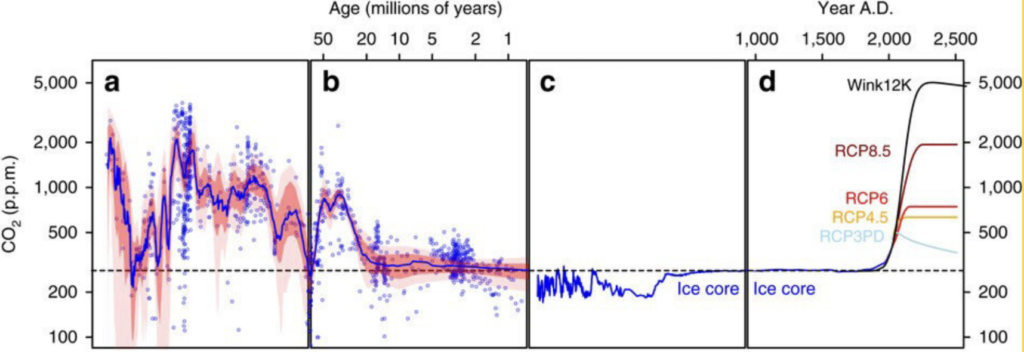
Historians look to the past so that we can learn from it and apply those lessons to our future. For climate change, we must look back at the Oligocene epoch, or from about 33.9 to 23.9 million years ago. That was the period when the atmospheric level of CO₂ declined from ~500ppm of CO₂ to the 300ppm level of CO₂ which has been the average for the last 10 million years. That change, in part, allowed for the environment in which humans evolved. Today, however, atmospheric CO₂ is at 415ppm, a 38% increase since 1750 when man made emissions began … and rising.

Figure 1: CO₂ levels over the past 500 million years. Foster et al – Descent into the icehouse.
This chart shows the history of CO₂ levels in the atmosphere and the predicted levels up to 2500. These numbers come from the Representative Concentration Pathways (RCP) published by IPCC. Under a high emission scenario (RCP8.5) it is expected to reach as high as 940ppm by 2100. Under a medium baseline/high mitigation case (RCP6) we are forecast to reach 640ppm by 2100. To have a 50% likelihood of staying within a 2-degree warming, we need atmospheric CO₂ at no higher than 450ppm.
Why is this at all important?
CO₂ levels are a consequence of the difference between CO₂ emissions (from decomposing biological material, volcanoes and burning fossil fuels) and sequestration (CO₂ stored in the ground, typically captured by plants and buried in sediments). So, to manage atmospheric CO₂ levels we first need to deal with additional emissions, cutting these by switching to carbon-neutral energy sources. We also need to develop processes, technologies and carbon-based businesses that will capture and indefinitely store the carbon already in the atmosphere.

Figure 1: CO₂ levels over the past 500 million years. Foster et al – Descent into the icehouse.
It will take a couple decades to move to truly carbon-neutral energy system, and during this time we will be burning fossil fuels, emitting >400 volcanoes worth of manmade emissions per year. The ~10-million-year Oligocene epoch gives us a blueprint of how long biological processes take to sequester enough carbon to reduce atmospheric CO₂ levels from our forecast high, to a more liveable level. Unfortunately, we don’t have 10 million years to allow the planet to return to a habitable state for humans.
While the change will seem slow to the individual, to the future historian the next couple decades are nothing more than a blip within which to make a transformative change.